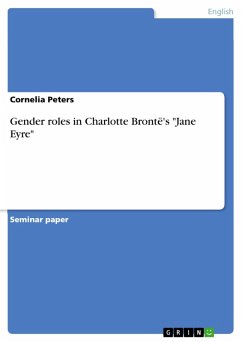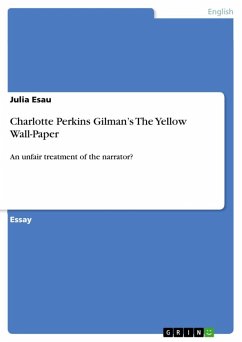
Madness and Confinement in Charlotte Perkins Gilman's "The Yellow Wall-Paper" and Charlotte Brontë's Jane Eyre (eBook, PDF)

PAYBACK Punkte
0 °P sammeln!
Studienarbeit aus dem Jahr 2005 im Fachbereich Anglistik - Literatur, Note: 1,5, Eberhard-Karls-Universität Tübingen, Veranstaltung: Gender: Reading and Writing between Romanticism and the 20th Century, Sprache: Deutsch, Abstract: A reader of nineteenth century literature by women is bound to encounter a striking coherence of theme and imagery throughout all genres. One of the recurring themes is that of madness and confinement. The often cited "Mad Woman in the Attic," who is locked away by male authority, appears as a central figure both in Charlotte Perkins Gilman's short story "The Yello...
Studienarbeit aus dem Jahr 2005 im Fachbereich Anglistik - Literatur, Note: 1,5, Eberhard-Karls-Universität Tübingen, Veranstaltung: Gender: Reading and Writing between Romanticism and the 20th Century, Sprache: Deutsch, Abstract: A reader of nineteenth century literature by women is bound to encounter a striking coherence of theme and imagery throughout all genres. One of the recurring themes is that of madness and confinement. The often cited "Mad Woman in the Attic," who is locked away by male authority, appears as a central figure both in Charlotte Perkins Gilman's short story "The Yellow Wall-Paper," written in 1890, and Charlotte Brontë's famous novel Jane Eyre,which was published in 1847. This essay will seek to explore similarities between the two works in respect to their description of madness as an escape from repressive social structures. The mad woman will be discussed as representing a rebellious double to the submissive heroine, who appears to be fragmented and confined by Victorian conventions of propriety. Emphasis will be laid as well on the medical treatment of mental illnesses that both texts deal with. It will be shown that gender-biased medical judgments made by men in both works actually have their origin in subconscious male anxieties.
Dieser Download kann aus rechtlichen Gründen nur mit Rechnungsadresse in A, B, BG, CY, CZ, D, DK, EW, E, FIN, F, GR, HR, H, IRL, I, LT, L, LR, M, NL, PL, P, R, S, SLO, SK ausgeliefert werden.













